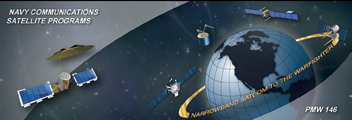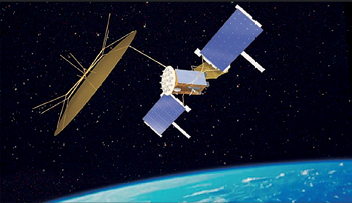The US Navy’s MUOS-4 Release
By Steven A. Davis, Space and Naval Warfare Systems Command Public Affairs
After a two-day delay due to tropical storm conditions, the Navy’s fourth Mobile User Objective System (MUOS) satellite launched at 6:18 a.m. EDT from Space Launch Complex 41.

MUOS-4, whose signal was acquired approximately three hours after launch, completes the initial operational constellation and provides near global network coverage for warfighters and combatant commanders.
This array allows mobile forces, including submarines, surface ships and aircraft, to communicate around the world via the narrowband spectrum.
User communities that will primarily benefit include ground forces at the individual soldier level but also include members of all services and special forces.
“The legacy satellite communication system allowed users to ‘talk’ as long as they were within the same satellite footprint,” said Navy Captain Joe Kan, program manager for the Communications Satellite Program Office. “MUOS allows troops all over the world to talk, text and share mission data seamlessly without having to worry about where they are in relation to a satellite.”
The program office falls under the Navy’s Program Executive Office for Space Systems, which has responsibility for the MUOS program and is located at the Space and Naval Warfare Systems Command in San Diego, California.
The Internet Protocol-based nature of MUOS allows network access to classified and unclassified networks. This network access for deployed tactical users will allow the exchange of critical situation awareness and targeting information.
“With the launch of MUOS-4 we’re going to deliver that worldwide coverage and communication service for users,” explained Nina Tran, the program office’s space division director. “The legacy payload we have on MUOS satellites allows a smooth transition to a newer, better MUOS capability. We are benefitting from providing the legacy channels for current users and we are exploring all the capability that MUOS has to offer.”
MUOS is an architecture comprised of a five-satellite constellation—a fifth on orbit spare to be launched in 2016— four ground stations across the globe, complex software to manage the network and an integrated waveform for use with user radios.
According to the program office’s technical director, Jim Parsons, it’s the system’s flexible design that allows rapid insertion of technology to keep the system up-to-speed.
“The nice thing about MUOS is that the ground system and terminals contain all the switching and routing technology,” Parsons said. “The satellite remains unchanged over time and can allow technology insertion into the ground stations and the waveform over time to increase capability without having to make any satellite changes.”
Commander Pete Sheehy, principal assistant program manager, explained that 24/7, beyond-line-of-sight communications will greatly benefit ground forces needing aviation support.
“With MUOS, the population of disadvantaged users is going to shrink considerably,” Sheehy said. “And that new population of folks who have beyond-line-of-sight communication are going to be able to do their jobs more efficiently and safely. It could be as simple as that one person who otherwise might not have had beyond-line-of-sight comms being able to say ‘This is where I am. This is who I am and I need help.’ And know that someone is on the other side to be able to provide that support.”
MUOS is already providing legacy communications to combatant commanders via active satellites on-orbit. MUOS’ advanced capability—Wideband Code Division Multiple Access—has been demonstrated in various environments, platforms and applications such as integration testing with the newest submarine antennas, Navy special operations scenario exercises and Air Force C-17 in-flight tests.
“In our testing we’ve tried to be as realistic as possible,” said Jarratt Mowery, director of end-to-end system testing. “In several events we’ve brought uniformed warfighters in and given them training on the MUOS system and operating its components. They were able to define the types of operations they would like to use with the system and allowed them to exercise those operations in a realistic environment. Be that in vehicles driving around, in a forest with a thick canopy or even in airborne platforms.”
An added benefit beyond the system’s initial requirements is extending communications further north and south toward the polar regions. This polar coverage, up to approximately 85 degrees in the Arctic under peak conditions, is significant considering that wireless and satellite communications has always been a struggle at extreme north and south latitudes.
Two MUOS satellites, launched in 2012 and 2013, are already providing legacy communications capability from their geosynchronous orbits over the Pacific Ocean and the United States.
MUOS-3, launched in January of this year, was accepted by the Navy in June after on orbit testing. The third satellite is awaiting final testing before being accepted for operational use.
Ultimately, the constellation and associated network will extend narrowband communications availability well past 2025.
The Navy’s Program Executive Office for Space Systems, located at the Space and Naval Warfare Systems Command in San Diego, is responsible for the MUOS program.
Space and Naval Warfare Systems Command
www.navy.mil/local/spawar/
The Orbital ATK Role
Orbital ATK, Inc. provided critical hardware for the September 2nd United Launch Alliance Atlas V launch from Cape Canaveral Air Force Station, Florida. The company contributed products on the fourth satellite in the US Navy’s Mobile User Objective System (MUOS), designated MUOS-4, and the United Launch Alliance (ULA) Atlas V launch vehicle.
Using advanced fiber placement manufacturing and automated inspection techniques, Orbital ATK produced three components for the ULA Atlas V vehicle, including the 10-foot diameter composite heat shield that provides essential protection to the first stage engine, the Centaur Interstage Adapter (CISA) that houses the second stage engine and the boattail that adapts from the core vehicle to the five-meter diameter fairing.
The structures were fabricated by Orbital ATK at its Iuka, Mississippi, facility. This is the 56th Atlas V launch using Orbital
ATK-built composite structures.
The ULA Atlas V rocket flew in the 551 vehicle configuration with a five-meter fairing, five solid rocket boosters and a single-engine Centaur upper stage.
Orbital ATK manufactured the Reaction Control System propellant tank for the ULA Atlas V at its Commerce, California facility.
This flight marked the 21st successful flight of the Orbital ATK retro motors. Eight of these solid motors provided thrust for separation of the spent first stage. The ULA Atlas V retrorocket is built at Orbital ATK’s Elkton, Maryland, facility.
For the MUOS-4 satellite, Orbital ATK provided multiple components and structures from the following company locations: San Diego, Goleta and Commerce, California; Magna, Utah; and Beltsville, Maryland.
The MUOS-4 is the fourth satellite in the Navy’s planned five-satellite MUOS constellation. Once the constellation is complete, MUOS satellites will provide a 16x increase in number of accesses over the current Ultra High Frequency (UHF) satellite system requirement.
MUOS-1, MUOS-2 and MUOS-3 launched respectively in 2012, 2013 and January 2015, and are already providing high-quality voice communications. MUOS-5 is expected to launch in 2016.
Executive Comment
“It was great to see another successful ULA Atlas V launch that flew Orbital ATK-produced structures and components for both the launch vehicle and satellite,” said Scott Lehr, President of Orbital ATK’s Flight Systems Group. “Once again, this is a really good example of the breadth of our product line and the critical role we play in almost every EELV launch.”
Orbital ATK’s Crucial Hardware Assets For The MUOS-4’s Launch
Orbital ATK, Inc. provided critical hardware for the September 2nd United Launch Alliance Atlas V launch from Cape Canaveral Air Force Station, Florida—the company contributed products on the fourth satellite in the US Navy’s Mobile User Objective System (MUOS), designated MUOS-4, and the United Launch Alliance (ULA) Atlas V launch vehicle.

Artistic rendition of the MUOS-4 satellite.
MUOS is the next generation in narrowband tactical satellite communications systems. The MUOS constellation, for which Lockheed Martin Space Systems is the prime contractor, will provide mobile warfighters with significantly improved and secure communications.
Using advanced fiber placement manufacturing and automated inspection techniques, Orbital ATK produced three components for the ULA Atlas V vehicle, including the 10-foot diameter composite heat shield that provides essential protection to the first stage engine, the Centaur Interstage Adapter (CISA) that houses the second stage engine and the boattail that adapts from the core vehicle to the five-meter diameter fairing. The structures were fabricated by Orbital ATK at its Iuka, Mississippi, facility. This is the 56th Atlas V launch using Orbital ATK-built composite structures.
The ULA Atlas V rocket flew in the 551 vehicle configuration with a five-meter fairing, five solid rocket boosters and a single-engine Centaur upper stage. Orbital ATK manufactured the Reaction Control System propellant tank for the ULA Atlas V at its Commerce, California, facility.
This flight marked the 21st successful flight of the Orbital ATK retro motors. Eight of these solid motors provided thrust for separation of the spent first stage. The ULA Atlas V retrorocket is built at Orbital ATK’s Elkton, Maryland, facility.
For the MUOS-4 satellite, Orbital ATK provided multiple components and structures from the following company locations:
San Diego, Goleta and Commerce, California; Magna, Utah; and Beltsville, Maryland.
The MUOS-4 is the fourth satellite in the Navy’s planned five-satellite MUOS constellation. Once the constellation is complete, MUOS satellites will provide a 16x increase in number of accesses over the current Ultra High Frequency (UHF) satellite system requirement. MUOS-1, MUOS-2 and MUOS-3 launched respectively in 2012, 2013 and January 2015, and are already providing high-quality voice communications. MUOS-5 is expected to launch in 2016.
“It was great to see another successful ULA Atlas V launch that flew Orbital ATK-produced structures and components for both the launch vehicle and satellite,” said Scott Lehr, President of Orbital ATK’s Flight Systems Group. “Once again, this is a really good example of the breadth of our product line and the critical role we play in almost every EELV launch.”
www.orbitalatk.com/
ND SatCom’s Partner Program
ND SatCom announces the official launch of its Partner Program for integrating its new SKYWAN 5G product as the key element in VSAT terminal solutions by selected partners.

Introduced in June this year, the highly anticipated SKYWAN 5G VSAT modem is now available with full capabilities for integration in all types of partner solutions.
SKYWAN 5G is flexible, scalable and reliable. The hardware design of this all-in-one compact unit provides full functionality on board. Whether a star, multi-star, hybrid or full mesh network is needed, SKYWAN 5G fits all topologies and supports switching to another topology over time.
SKYWAN 5G also plays any network role such as hub or remote, thereby simplifying logistics and customs’ handling, and enables unprecedented scalability as demand for network growth increases.
Additionally, SKYWAN 5G can be, with this new partner program, reliably integrated in Manpaks, Fly-Aways or any other VSAT solution.
SKYWAN 5G includes an MF-TDMA modem and is capable of achieving significant data rates. Designed as an all-in-one device with high network redundancy and a wide range of IP support, SKYWAN 5G allows data to be transmitted in a single hop directly from their origin to their destination, thereby avoiding double hops and extra delays. Bandwidth is dynamically allocated as required, generating savings in satellite capacity cost.
www.ndsatcom.com/
DoD Initiates Combined Space Ops Center @ Vandenberg AFB—JICSpOC
The Department of Defense announces the agency will establish a Joint Interagency Combined Space Operations Center (JICSpOC), in conjunction with U.S. Strategic Command, Air Force Space Command, and the intelligence community.

The center, to be located at Schriever Air Force Base in Colorado Springs, Colorado, will create unity of effort and facilitate information sharing across the national security space enterprise. The new JICSpOC will improve processes and procedures, ensuring data fusion among DoD, intelligence community, interagency, allied and commercial space entities.
The JICSpOC will have embedded capabilities that enable it to provide backup to the Joint Space Operations Center (JSpOC), located at Vanderberg Air Force Base, California, but is not intended as a replacement for the JSpOC. The JICSpOC will be located within existing facilities on Schriever AFB. Military construction funding is not required.
The center will have the capability to develop, test, validate and integrate new space system tactics, techniques and procedures in support of both DoD and Intelligence Community space operations.
The increasing threats to space capabilities necessitates better operational integration of these two space communities, as well as civil, commercial, allied and international partners. The JICSpOC experimentation and test effort will boost the ability to detect, characterize, and attribute irresponsible or threatening space activity in a timely manner.
Ultimately, the output of the JICSpOC will enhance U.S. space operations, contribute to operational command and control within the DoD, and improve the nation’s ability to protect and defend critical national space infrastructure in an increasingly contested space environment.
Along with JSpOC, the new JICSpOC will support the Joint Functional Component Commander for Space, the Space Component Commander for USSTRATCOM. An initial cadre of approximately 30 personnel will develop the facility, network and analytic requirements, as well as the skill sets and organizational representation required to provide the proper experimentation and testing environment for the JICSpOC. Membership of this initial group will come from the DoD and the Intelligence Community. Additional personnel from these and other stakeholders will be added as the detailed experimentation plan is refined.
Preparatory activities have already commenced. Operational experimentation and testing will begin on 1 October 2015. Completion of the initial series of experiments, including incorporation of the results into standard operating procedures, is expected by January 1, 2017.



